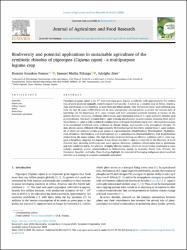/admin/item?itemID=9972aee3-d893-4273-890a-5804e1a5b0e4
Biodiversity and potential applications in sustainable agriculture of the symbiotic rhizobia of pigeonpea (Cajanus cajan) - a multipurpose legume crop

Ver/
Tipo de acceso
AbiertoTipo de Material
ArtículoTipo de Contenido
Investigación científicaIdioma
InglésAudiencia
Técnicos, profesionales y científicosColección
- Investigación ambiental [1758]
Metadatos
Mostrar el registro completo del ítem| Sinopsis: | Pigeonpea (Cajanus cajan) is the 6th most important grain legume worldwide, with approximately five million tons of grain produced annually, contributing to food security. It serves as a versatile crop in Africa, America, Asia, and Oceania and is beneficial to more than one billion people. This bibliometric study used published data from the last 35 years (1990–2024) and de novo phylogenetic reconstructions to review the current state of knowledge on the importance of C. cajan cultures and their associated symbiotic bacteria. It focuses on the genetic diversity, taxonomy, symbiotic effectiveness, and valorization status of C. cajan symbiotic rhizobia used as biofertilizers. The study revealed that C. cajan is facing abandonment in some regions, including West Africa. Nevertheless, C. cajan is still considered a multipurpose and highly beneficial crop in over 100 countries because of its exceptional nutritional value, resilience to climate change, and capacity to fix atmospheric nitrogen. To date, diverse strains affiliated with approximately 20 rhizobial species have been isolated from C. cajan nodules, all of which are scattered within seven genera of α-proteobacteria (Bradyhizobium, Mesorhizobium, Phyllobacterium, Rhizobium, Neorhizobium, and Sinorhizobium) and β-proteobacteria (Paraburkholderia), with Bradyhizobium strains being the major isolates. The high diversity of strains forming an effective symbiosis with C. cajan suggests a broad host range for this legume. It was shown also that C. cajan is a reservoir for the discovery of novel rhizobial taxa, including symbiovars and novel species. Moreover, symbiotic effectiveness tests in greenhouse and field conditions led to the selection of highly effective isolates, which are being further challenged to meet industry standards and/or commercialized as biofertilizers, mainly in Australia, Brazil, Côte d’Ivoire, the Dominican Republic, and India. These findings highlight the potential of leveraging indigenous plant-beneficial microbes as a strategy to promote sustainable agriculture. |
| Autor(es): | Kouakou Fossou, Romain
Mathu Ndungu, Samuel Zézé, Adolphe |
| Año: | 2025 |
| Publicado: | Journal of Agriculture and Food Research, 102328 |
| Citación: | Fossou, R. K., Ndungu, S. M., & Zézé, A. (2025). Biodiversity and potential applications in sustainable agriculture of the symbiotic rhizobia of pigeonpea (Cajanus cajan)-a multipurpose legume crop. Journal of Agriculture and Food Research, 102328. Recuperado de: |
| URI: | https://bvearmb.do/handle/123456789/6748
|

